- Sharing stories about teaching and learning
- Employment rate remains solid
- Feeding 5,000 daily at the Senior Open
- Creating a menu for State Fair youth
- Designing a better package for Rayovac
- Building prototypes for regional industries
- Solving problems with inventions
- Pairing wine and food in Australia and Spain
- Improving literacy skills of area children
- Teaching high school students about stream ecology
Goal 2:
Preserve and enhance our educational processes through the application of active learning principles
Sharing stories about teaching and learning
The UW-Stout Teaching and Learning Center completed its second year of operation with a number of activities. The center:
- sponsored a series of noontime Lessons Learned sessions throughout the academic year to encourage faculty and staff to share instructional ideas related to learning, teaching and technology. Session facilitators led informal discussions about a variety of topics, from the meaning of learning to the role of research in the classroom.
- hosted Celebrate Teaching Day by leading a lively discussion about "The Courage to Teach," a book by acclaimed writer Parker Palmer. Early in the semester, the center distributed copies of the book to all departments, encouraging instructors to read Palmer's ideas. The Provost's Office and the Chancellor's Office co-sponsored this activity.
- participated in the ongoing process of evaluating the impact of the e-Scholar program on active learning, critical thinking and teaching.
- created a Scholarship of Teaching cohort to investigate the relationship between student learning and teaching approaches.
- developed a new Web-based discussion board that encourages instructors to share stories about teaching and learning with laptops.
Employment rate remains solid
 UW-Stout
graduates are experiencing a slow economy, diminished by the dot com bust;
the September 11, 2001 terrorist attacks; and the unraveling of several
big corporations. As a result, UW-Stout's employment rate dropped slightly
but still remains solid.
UW-Stout
graduates are experiencing a slow economy, diminished by the dot com bust;
the September 11, 2001 terrorist attacks; and the unraveling of several
big corporations. As a result, UW-Stout's employment rate dropped slightly
but still remains solid.
- Within six months of graduating, 95.03 percent of UW-Stout's 2001-02 graduates are working or continuing their education.
- Of those employed, 86.3 percent secured jobs in or related to their major.
- The median yearly salary reported by all working graduates was $30,000.
- More than 98 percent of 2001-02 graduates from UW-Stout's masters and education specialist degree programs are working or continuing their education.
More than 2,200 students participated in, and 217 employers registered for, the university's 2002 three-day career conference. In addition, more employers are hiring UW-Stout students as co-op/interns than ever before.
- During the 2001-02 school year, 589 students -- up from 559 the previous academic year -- received valuable work experience through UW-Stout's co-op program.
- Co-op students reported average earnings of $11.87 per hour while on assignments.
- Wages paid to the 2001-02 co-op class totaled more than $4.7 million.
- More than 350 employers provided co-op or intern job sites.
Feeding 25,000 daily at the Senior Open
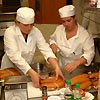 Twenty-two
students in UW-Stout's summer Quantity Food Production course, their instructor
and four teaching assistants served more than 25,000 fans daily at the
weeklong 2002 U.S. Senior Open Championship in Baltimore. Working under
contract with Prom Management Group Inc., a Minnesota-based catering service,
the students cooked and served upscale breakfasts, fancy lunches and late
afternoon hors d'oeuvres to guests in more than 40 corporate hospitality
tents.
Twenty-two
students in UW-Stout's summer Quantity Food Production course, their instructor
and four teaching assistants served more than 25,000 fans daily at the
weeklong 2002 U.S. Senior Open Championship in Baltimore. Working under
contract with Prom Management Group Inc., a Minnesota-based catering service,
the students cooked and served upscale breakfasts, fancy lunches and late
afternoon hors d'oeuvres to guests in more than 40 corporate hospitality
tents.
To prepare for the golf championship, the students strengthened their
commercial food production, management, service, sanitation and food safety
skills by planning, preparing and offering five meals to the public at
"Corner III," a restaurant laboratory in UW-Stout's Home Economics
Building.
Creating a menu for State Fair youth
Thanks to a UW-Stout instructor and two students, hundreds of youth exhibitors
lodging at the Tommy G. Thompson Youth Center ate better food during the
State Fair. In collaboration with Milwaukee Area Technical Colleges, the
Private Industry Council of Milwaukee County and the State Fair Park,
they planned new menus, balancing nutritional value with recipes that
appeal to youngsters.
The UW-Stout students also worked as on-site managers at the youth center
during the State Fair, supervising more than 41 inner city Milwaukee high
school students. PIC chose the high school students based on their interest
in food service management as a career, and MATC provided culinary arts
training to them.
Designing a better package
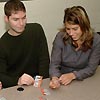 Students
in UW-Stout's packaging program gained real-life experience as they worked
with Rayovac to design new packaging for the company's hearing aid batteries.
Changes in the packaging of the company's competitors led Rayovac to seek
new ideas in order to maintain their dominant market share.
Students
in UW-Stout's packaging program gained real-life experience as they worked
with Rayovac to design new packaging for the company's hearing aid batteries.
Changes in the packaging of the company's competitors led Rayovac to seek
new ideas in order to maintain their dominant market share.
The company asked the three student groups to produce a new design that
works for different battery sizes, protects the batteries from losing
their strength and increases the value of the product without increasing
the cost.
After conducting research, the groups drew their designs using Computer
Aided Design and created prototypes using rapid prototyping equipment.
They presented their final prototypes to nine executives at Rayovac's
Corporate Headquarters in Madison. The company reported that they plan
to adopt several of the students' concepts.
Building prototypes for regional industries
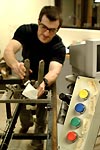 For
their senior-level Capstone experience, students in UW-Stout's manufacturing
engineering program built custom automated machines for Toro, a lawn care
device company, and QA1, manufacturers of after-market suspension components.
For
their senior-level Capstone experience, students in UW-Stout's manufacturing
engineering program built custom automated machines for Toro, a lawn care
device company, and QA1, manufacturers of after-market suspension components.
The Toro student engineering team designed and fabricated a semi-automated
cell that transports a variety of similar shaped parts of different sizes
to a robotic welder, separating the operator of the machine from the actual
welding. The QA1 team designed and built an automated assembly that inserts
rubber bushings into automotive shocks, eliminating the need for a full-time
worker to insert the bushings manually.
To design and build the custom cells, both teams researched their clients'
needs, justified costs, stayed within the companies' specified budgets
and ordered materials. The two teams presented their finished prototypes
to UW-Stout instructors, administrators and company representatives. Toro
and QA1 actually plan to put the teams' prototypes into production.
Solving problems with inventions
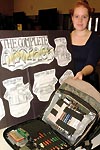 Students
in UW-Stout's exploring technology course developed and exhibited more
than 200 inventions that solve problems by enhancing human abilities.
The students either built working models of their inventions or constructed
prototypes.
Students
in UW-Stout's exploring technology course developed and exhibited more
than 200 inventions that solve problems by enhancing human abilities.
The students either built working models of their inventions or constructed
prototypes.
As part of the course, the students thoroughly researched and wrote about
the technologies and scientific concepts related to their inventions.
This helped them understand the theories behind their ideas, even if they
do not have the technical know-how to literally produce them. Many of
the students also created a company concept related to their inventions,
complete with missions and marketing strategies.
Pairing wine and food in Australia and Spain
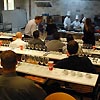 Students
in UW-Stout's hospitality and tourism program learned about the wine,
food and cultural aspects of major wine producing countries through three-week
wine and food pairing courses offered in Australia and Spain.
Students
in UW-Stout's hospitality and tourism program learned about the wine,
food and cultural aspects of major wine producing countries through three-week
wine and food pairing courses offered in Australia and Spain.
During their travels, the students developed an applied approach to matching
Australian and Spanish wine and food using complementing flavors, textures
and components. The courses also emphasized menu planning, food preparation
and cooking methods. In both countries, the students ended the course
by preparing four five-course meals, serving complementary wines.
Australia
The Australia course was taught in August at Southern Cross University in Coffs Harbor. Students started their wine and food pairing experience in Sydney, and then toured vineyards and wineries in the Hunter Valley.
Afterward, the students matched Australian wines, including Shiraz, Semillion,
Chambourcin and Verdelho, with food available in the local markets. In
doing so, they consumed exotic dishes, such as kangaroo, alligator, ostrich,
caviar and wild duck.
Spain
In January, the Spain course was taught at the University of the Balearic Islands in Majorca. Students took vineyard and winery tours in Sherry and Seville on the mainland, including the Gonzalez Byass winery famous for excellent sherries. They also explored the island wines and foods of Majorca.
The students then interacted with UIB students during a three-day tasting session of Spanish and American wines and food. They ate and matched foods, such as Paella, Tapas, wild boar, lamb, elk and swordfish, with Spanish wines, including Tempranillo, Garnacha, Mazuelo, Macabeo, Parellada and Cava.
Improving literacy skills of area children
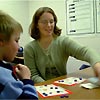 UW-Stout
students worked to improve the reading skills of area elementary school
children through the America Reads Challenge, a Federal Work Study program.
The eleven students tutored children in reading and language arts skills
at the seven regional elementary schools.
UW-Stout
students worked to improve the reading skills of area elementary school
children through the America Reads Challenge, a Federal Work Study program.
The eleven students tutored children in reading and language arts skills
at the seven regional elementary schools.
The students worked on a variety of projects with children who range
in age from preschoolers to fifth graders. Some of the tutors assisted
English as a Second Language students. Several participated in one-to-one
tutoring. Others implemented a special reading program purchased by one
of the schools.
As elementary schools become more and more strapped for resources, this
program allows them to provide individual services to children who otherwise
may not get additional attention. In addition, the program helped UW-Stout
meet its requirement to use Federal Work Study funds for community service
programs.
The majority of the tutors were early childhood education majors who are
required to take three reading and language arts courses during their
college career. Other student majors included art education, and family
and consumer sciences education.
Teaching high school students
about stream ecology
UW-Stout biology students helped high school students from the area Lucas
Charter School study the ecology of the local Gilbert Creek. Under the
direction of the Dunn County Land Conservation Office, the university
students taught the Lucas students how to measure stream depth, width
and water speed.
The Lucas students also had the opportunity to learn how to calculate
velocity and flow, measure dissolved oxygen, and identify bugs they collected
from the creek bottom.
Additional Resources:
- Teaching and Learning Center
University of Wisconsin-Stout
http://www.uwstout.edu/cas/english/stoutteachnet/ - America Reads Challenge
U.S. Department of Education
http://www.ed.gov/inits/americareads/
